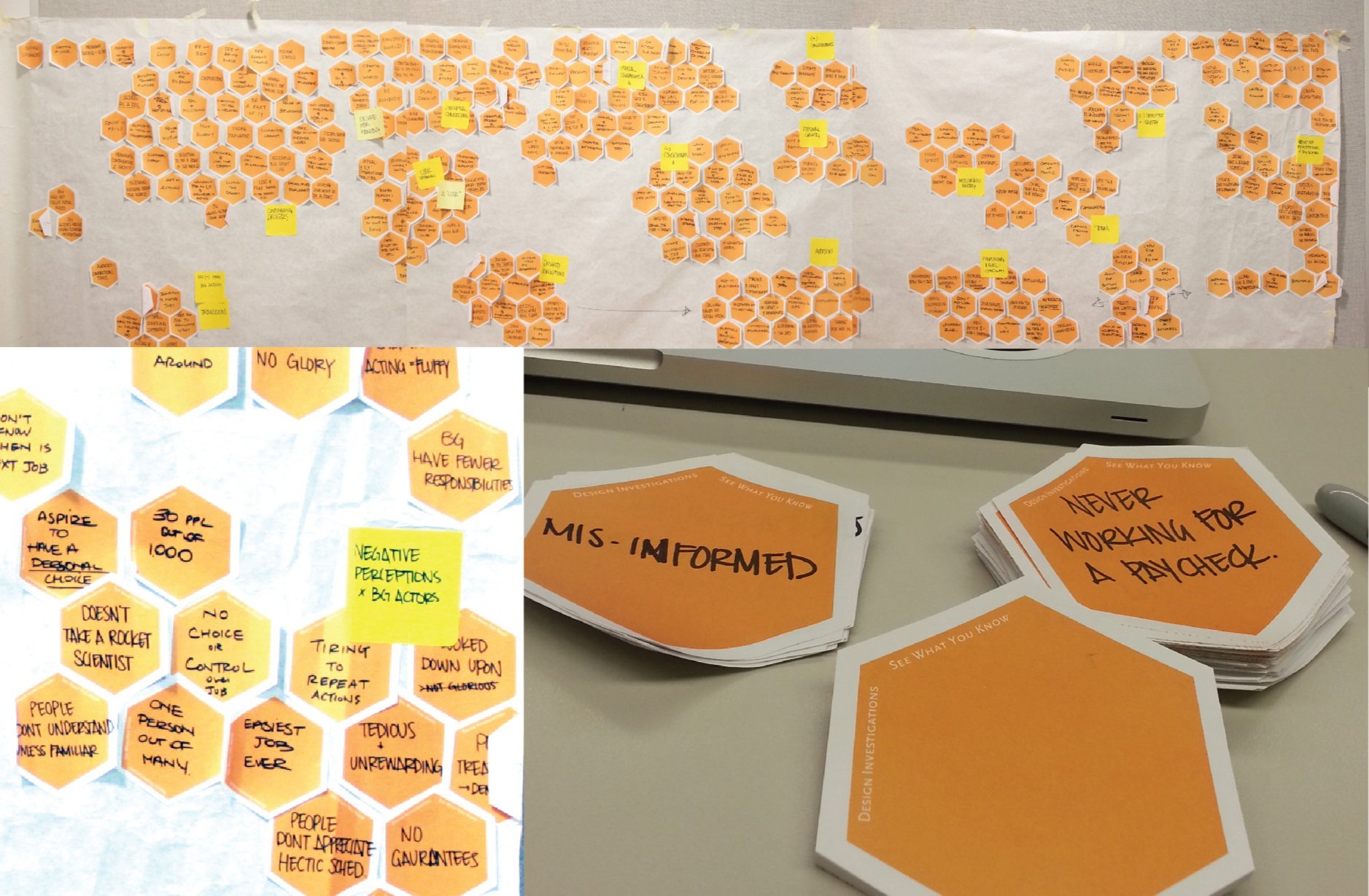GOAL
To understand the daily life and motivations of background actors, and the Hollywood movie industry via their perspective.
INTRO
A 14 week qualitative research investigation into the experience of being a background actor in Los Angeles, to gain insight for design opportunities to improve working conditions in Hollywood.
Expectations
We expected that the “Extras” community was a place of last resort for people careerwise because of popular perceptions that background actors do not need to have much talent to find work.
Conclusion
Unlike the “lazy” stereotype, Background Actors are industrious people whose time is constantly occupied by either working on-set or else working elsewhere in order to survive until the next job on-set. Their love of the on-set experience and desire to be a part of something bigger than themselves trumps all manners of economic and psychological hardship.
Outcomes
Based on gathered insights, we found design opportunities to assist background actors with their daily lives and achieving their goals.
Who are Background Actors?
Individually unseen, yet as a group omnipresent, background actors, or BG, or “extras” are the people who create the scene for the main actors to act in. Without background actors, there would be no ambiance.
The Base and the Heart of Hollywood
Background acting is the beginning stage for many in the film industry. To gain insight into what makes the film industry tick, we thought we’d start with the people who make up the basic building blocks of creating the world of film.
User Interviews
Recruitment
5 interviewees were recruited from a mixture of friends of friends or people we knew. We selected veteran background actors of a varying spread of race, sex, and experience, between the ages of 20-40, and who were currently active in auditioning or working in background acting.
Interviews were conducted in-home or else in a neutral location, from across the Greater Los Angeles and Orange County area.
Limitations: We were unable to procure experienced veterans of a wider age range, and were limited to only able-bodied English-speaking background actors.
Interviewees are listed below. Two of the participants likenesses have been filtered for their privacy.
B
Veteran BG Actor
College major in theater production, stage acting
K
Veteran BG actor
college major in film
multi-coast experience in both NYC and LA
multi-crew experience in both BG and camera crew
Experience hosting
S
Veteran BG actor
Veteran actor
insights on the POC experience in auditioning
A
Veteran BG actor
Veteran Stand-in
College major in screenwriting
M
Veteran BG actor
Veteran stand-in
Insights on the POC experience in auditioning
Expert Interviews
We interviewed two subject matter experts to help gain insight on the overall process behind the management of background acting.
Jeff Olan
Casting Director
over 20 years of experience in the industry
owner of Jeff Olan Casting
casts BG actors according to assistant director’s specifications
Dave Goldfarb
2nd Assistant Director
Working in the Director’s Guild for over 20 years
Works with BG actors on set every day
Directs BG actors
Analysis
Journey Mapping
We asked participants to describe to us in pictures the daily process of getting ready for the job, and place the pictures higher or lower in the chart depending on how they felt about it during that time.
Understand process and a day in the life
Understand motivation, the emotional variations throughout the actors process of responding to a cattle call.
Journey maps revealed not only the process of living day to day, but the variations of the process depending on the mode of the Background Actor.
When working on-set, the day is very regimented, but emotions are more likely to be affected by others. When not on-set, the day is extremely random, but emotional state is more stable.
Trade-Off Exercise
We made a visual deck comparing values based on money, fame, being part of a community, the art of acting, and others. We had them choose which of these they prioritized over others.
We chose this technique to understand motivation - the personal values and motivating factors for continuing in such a difficult field.
The trade-off exercise revealed that participants were in the profession out of a sense of personal integrity - to do what they could to live and work as an artist or be true to their own selves.
The sense of having freedom was the commonly cited reason for starting in background acting, as well as continuing. Fame and fortune was very low on the ranking.
Card Sort Exercise
We prepared cards that relate to self image, using Dixit cards as a base. We asked each participant to choose two to represent themselves as a person, and one to represent themselves when working, then lastly, one to represent their selves as they aspire to be.
We chose this exercise to understand participants sense of self-perception, how they think of themselves.
The trade off exercise revealed that participants were in the profession out of a sense of personal integrity to do what they could to live and work as an artist.
Commonly cited themes:
building a career
rebelling / escaping the regular world
discovering a true self
Camera Study
We asked participants to document their way of life over the course of one week as it pertained to their job seeking and job performance. We used the camera diary before the interview as a way to generate further discussion about participants personal lives and priorities, and how they spent their free time.
We chose this study to see how participants see the world, by understanding trends and places and activities amongst the cattle call community members.
Mind Mapping
After concluding all the interviews, as a team, we created a mind map of all important information from what we had learned, then sorted each piece of information by affinities. Surprisingly, the biggest clusters ended up being almost overwhelmingly negative with the most number in these themes:
Negative perceptions of Background Actors
Consequences of Continuing the Work
In third place was a positive theme:
3. Reasons to Continue the Work
Synthesis
Analysis Filters
We gathered and applied PNSTIO analysis filters to futher gain insight from the information. Below is a selection of the work:

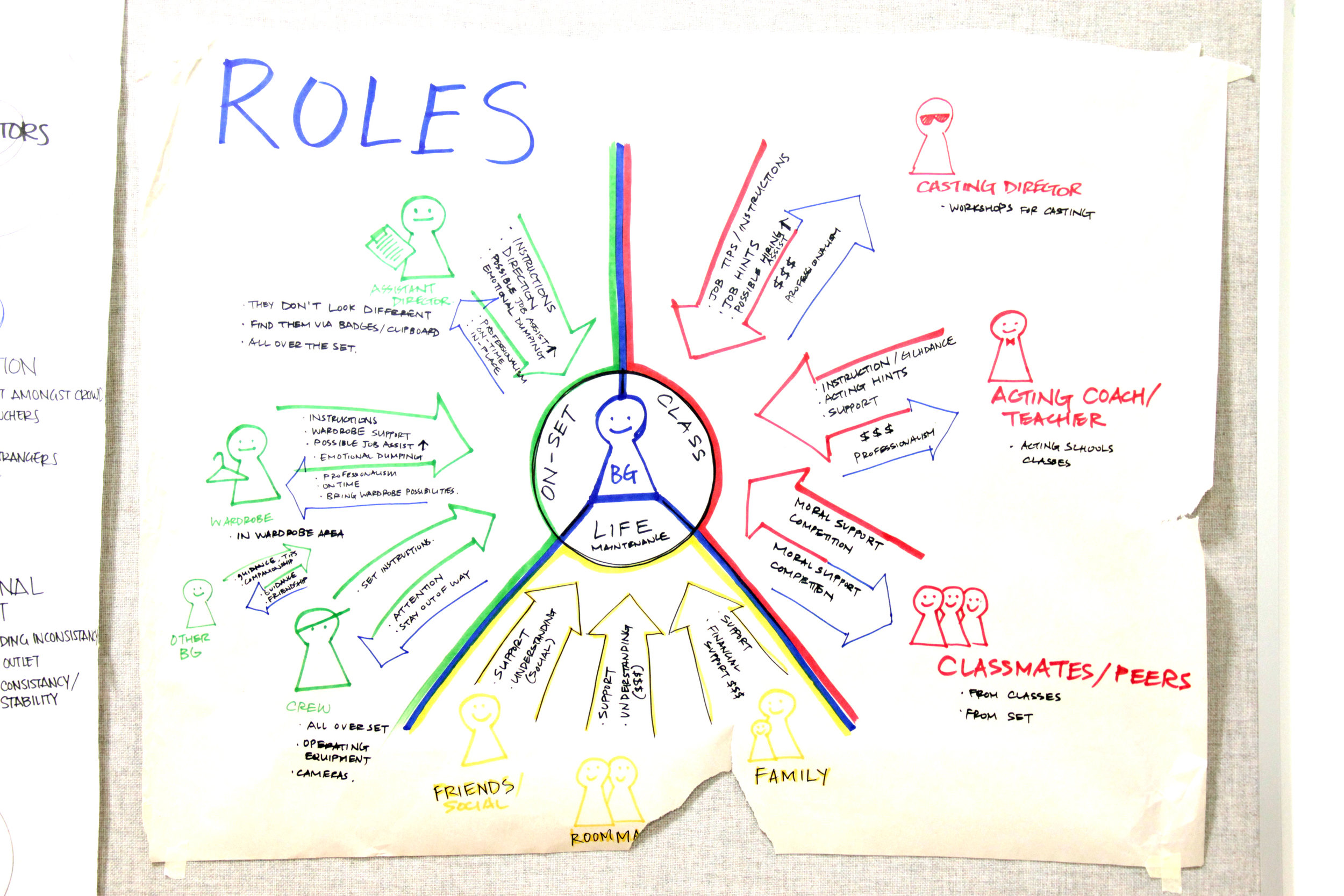
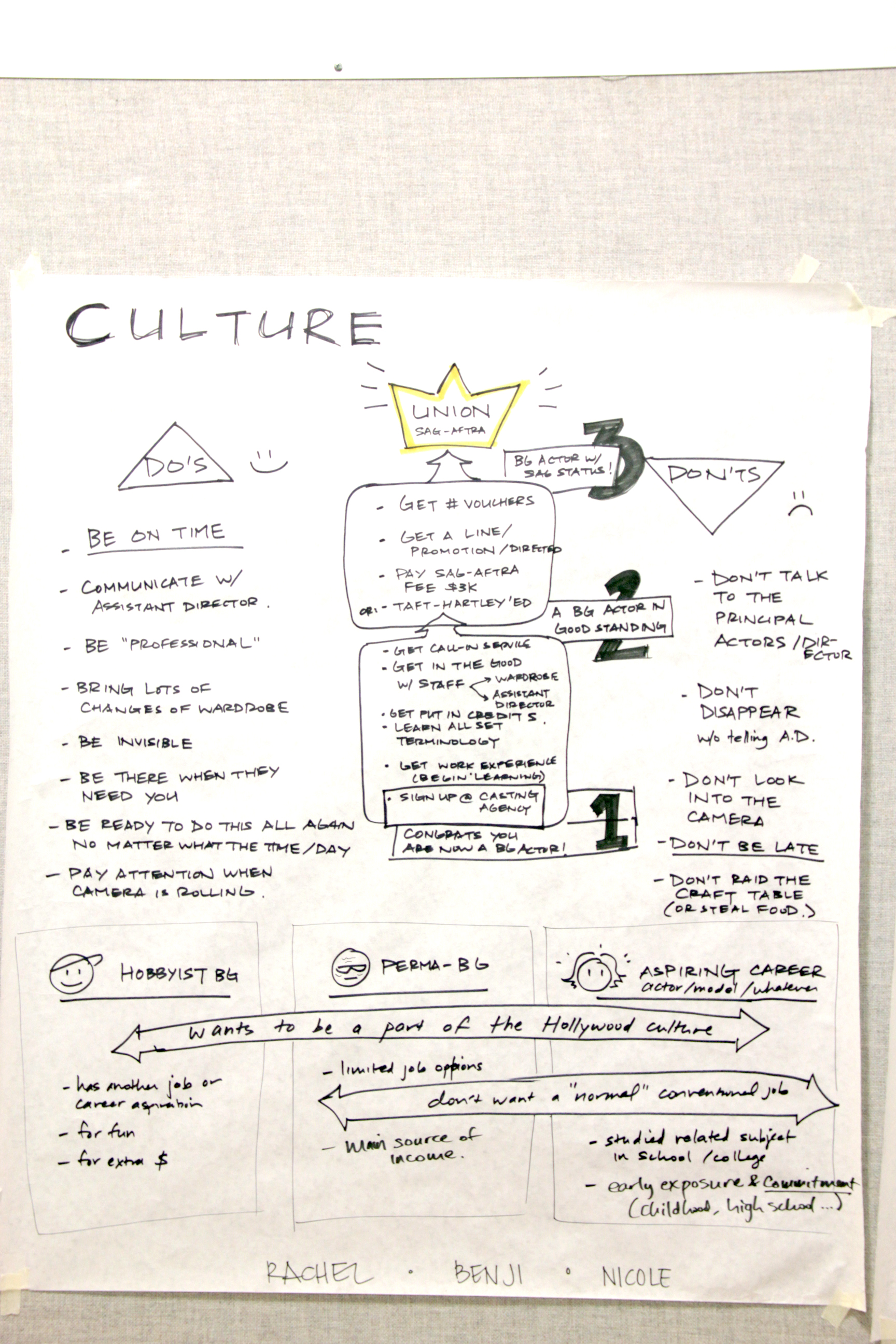
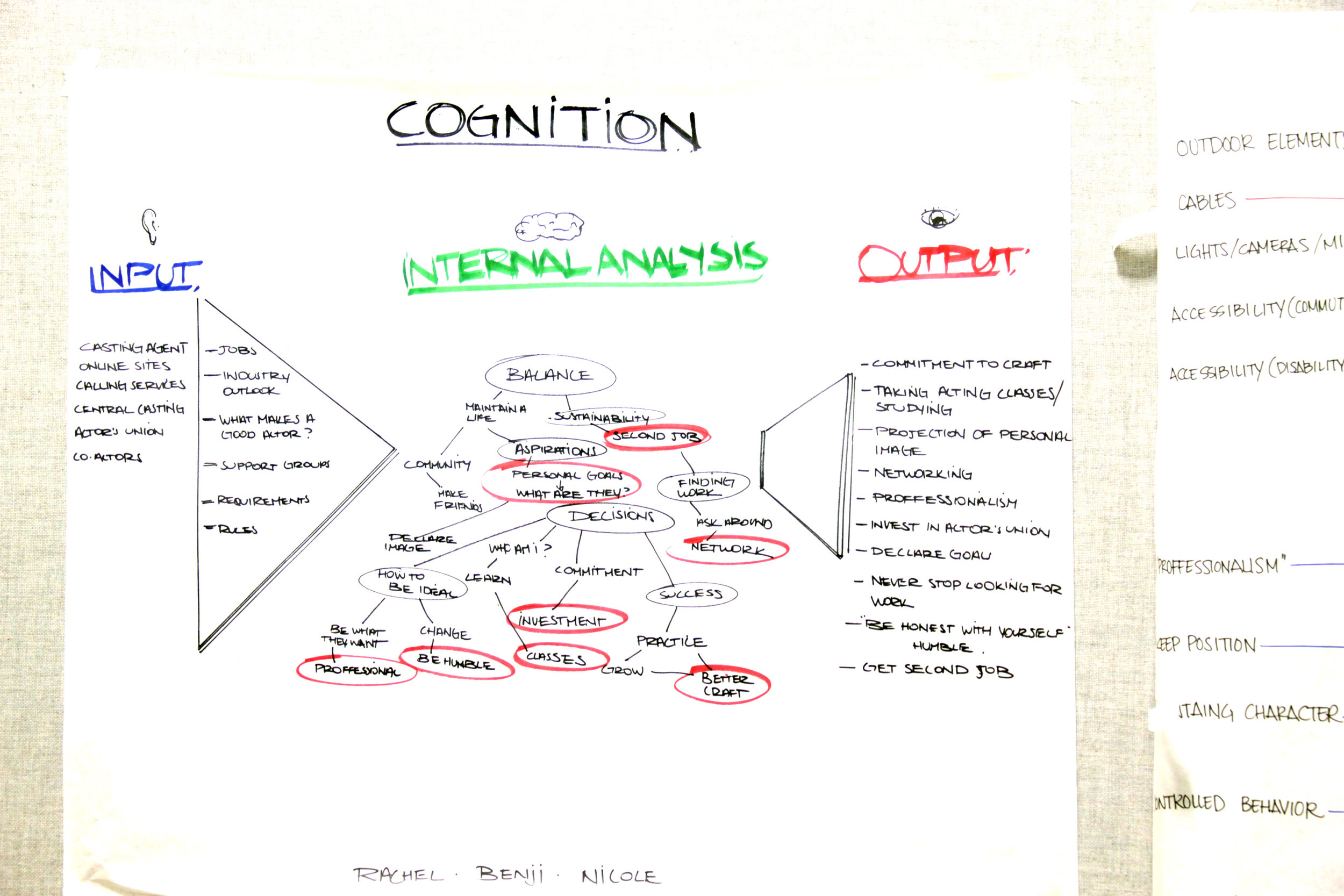
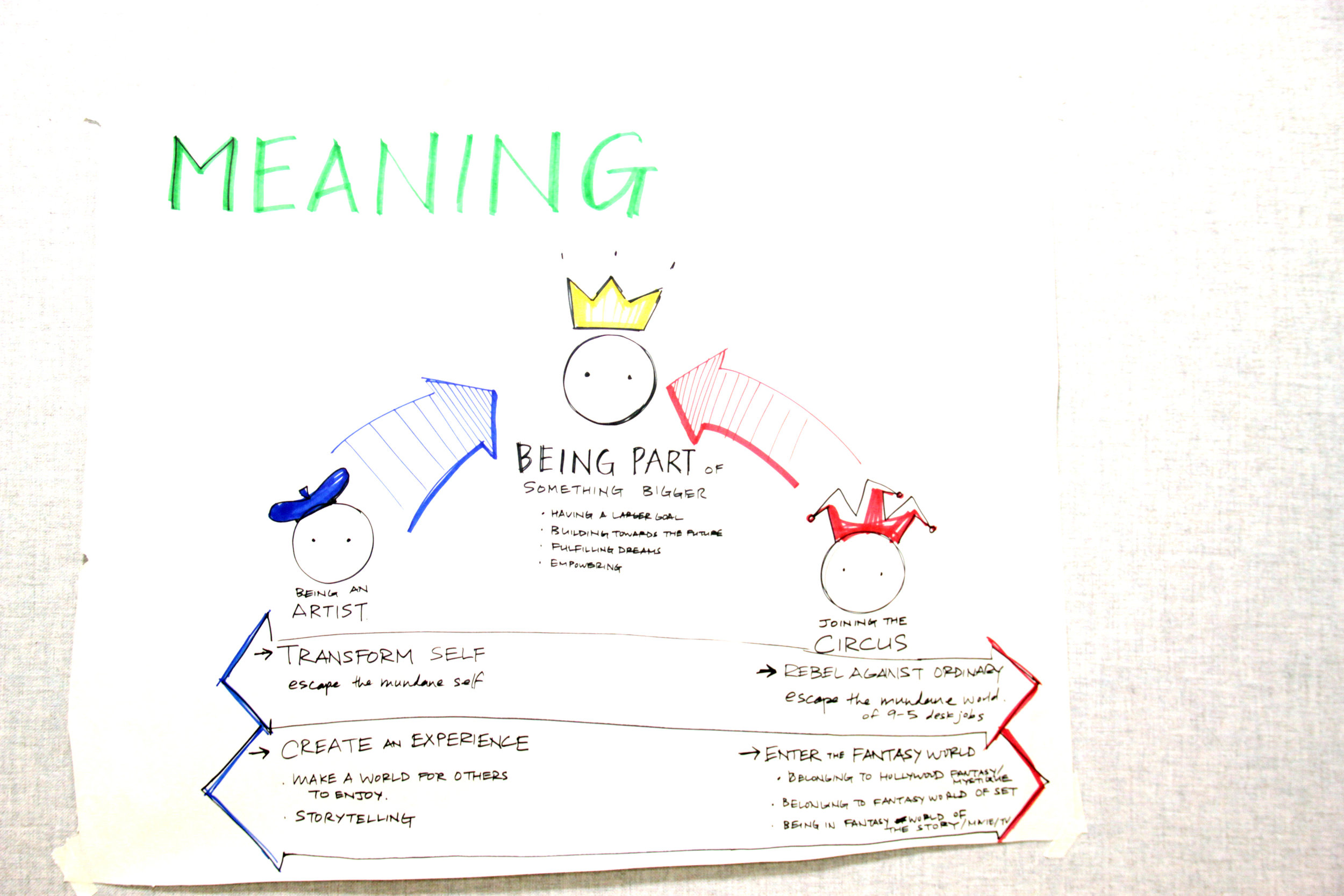
Main Themes
Out of all the interactions happening in the ecosystem of the background acting, space, 8 recurring themes set the tone for the experience of the background actor.
Downtime
Miscommunication
Odd Jobs
The Big Break
Time Management
Introspection
Neverland Effect
Industry Serf
Insights and Opportunities
From each theme, we extracted the key insight and possible design opportunities to address what was happening to our participants.
Conclusion
The pursuit of background acting as a full time career would seem overwhelmingly full of negatives:
Love will Overcome
Background actors are people for whom the experience is worth the cost: The dedicated background actor is set apart from others in that the desire to live a life of authenticity to their persception of their true selves as well as the love of the fantasy of the on-set experience are enough to overcome all manners of hardship and struggle.
Team Project Members
This study was conducted as a part of undergraduate studies in the product design department at ArtCenter College of Design. Members selected for this team:
Nicole Eng
Rachel Choung
Benji Kuroda
My roles:
Interviewer
Recruiter
Documentarian (Note taking, Video recording)
Video Editing
Analysis Filters, Synthesis












